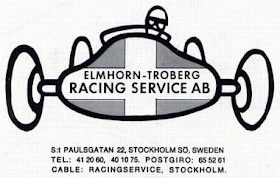Okay, enough about the well-known and sought after Mini derivatives now. I've been writing about Unipowers, Broadspeeds, Mini Marcoses and Ogles so much lately that it's about time for something from the other end of the spectrum. The really obscure stuff. So how about a prototype from England's North-East, which I'm pretty sure you've never heard of? Meet the WM Special, built by Mike Findeisen and his son Nick in Bishop Auckland, county Durham in 1981/1982. You may have heard of the Findeisens, though, as they came up with the NCF Blitz in later years. A Mini based buggy they will
still build for you. But the WM was their first Mini motorised creature, named after Whittington Mill - the actual place where the thing was built.
Starting point for the special was a rotten Mini that was found in a field nearby and bought for 20 pounds. It appeared to have good subframes, though, and a steel frame with four longintudinal members was made, upon which these subframes were bolted. An aluminium body followed and the Findeisens admitted it wasn't the prettiest, but as it was purely intended as a testbed this didn't really matter to them. Once the car was finished and thoroughly testdriven over the rough farm roads (loosing the battery frequently!) the two men turned to the Vehicle Licensing Office nearby (run by a local policeman) and were given a brand new 'W' registration. Total costs for designing, developing, building and licensing the car: 520 pounds.
By this time the Findeisens unveiled their plans to turn their prototype into production as a 2+2. Kit Car magazine caught up with them and wrote: "It's the forerunner of a new line of kit cars. Most of the lessons learned from the WM are now tucked up in a much more exciting and attractive car, of which an early preliminary styling sketch is shown here. An aluminium bodied, fixed head coupe. The new car features 2+2 seating and uses a Mini front subframe with 1300 A-series power. Estimated price at which people will be able to buy the aluminium and steel body/chassis unit is about 1000 pounds, and the launch date is set for June."
But June 1982 passed and not much happened. The Findeisens decided the kit car scene offered far too many sports cars in the early 1980s and thus decided to concentrate on something thoroughly different. The terrain vehicle became their thing. And the Ford based NCF Diamond was their first car in 1984, not without success. It was followed by the Mini based buggy
NCF Blitz, which Nick is building to this very day, along with
Land Rover Discovery based and
Suzuki Vitara based vehicles. There's even
an owner's club. Nick says he has no idea if the WM Special still exists, and neither has any pictures or other stuff of it left. He does remember one 2+2 version was built, though, but again has no idea if it could still exist and has nothing to prov its existed either. Now, you know I'm in for a surprise, so if you do happen to know more about it...
Galvanised steel tubes were used to build the chassis, while the body was all aluminium
Picture via Peter Camping/Kit Car magazine
Out on a test drive in Englands rural North East. The dog had to do as a passenger
Picture via Peter Camping/Kit Car magazine
850cc Mini engine and 12" Hilman Imp wheels. It did 80+mph and 40-45 mpg
Picture via Peter Camping/Kit Car magazine
Not the prettiest, but strong and durable and showed what could be done on a limited budget
Picture via Peter Camping/Kit Car magazine
Painted and ready to go with a brand new 'W' registration in 1982. Does it survive?
Picture via Peter Camping/Kit Car magazine
This is a styling sketch for the 2+2 production version. One was supposedly built
Picture via Peter Camping/Kit Car magazine





























